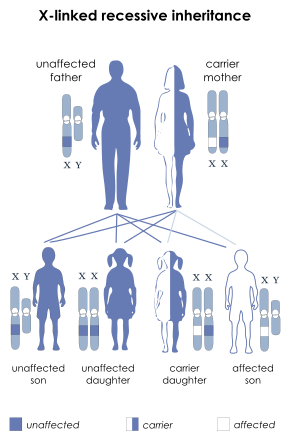Red-green colour blindness in humans
What is Colour blindnes?
Colour blindness is a condition where the eyes have trouble distinguishing certain colours. Red - green colour blindness is a common one.
Red-green color blindness is a generic term for protanopia (red-blindness) and deuteranopia (green-blindness).
More than 99% of all color blind people are suffering from a red-green color vision deficiency.

These color charts show how different colorblind people see compared to a person with normal color vision.
Causes
The area at the back of the eye, called the retina, is sensitive to light and colour. It contains specialized cells, called cones, which respond to colour. There are three types of cone cells. One responds best to red light, one to green light, and one to blue light. When a specific type of cone cell doesn't work properly, a person will have trouble seeing the colour that particular cone cell responds to. For example, a person with red colour blindness has a defect in red cone cells.
- For the vast majority of people with deficient colour vision the condition is genetic and has been inherited from their mother
- some people become colour blind as a result of other diseases such as diabetes and multiple sclerosis
- Or they acquire the condition over time due to the aging process.
- Vitamin A deficiency may also cause color blindness.
Inheritance pattern of colour blindness
Color blindness is typically an inherited genetic disorder. It is most commonly inherited from mutations on the X chromosome.
Males are at a greater risk of inheriting an X-linked mutation because males only have one X chromosome (XY, with the Y chromosome carrying altogether different genes from the X chromosome), and females have two (XX);
In X-linked inheritance, the mother carries the mutated gene on one of her X chromosomes and will pass on the mutated gene to 50 percent of her children. Because females have two X chromosomes, the effect of a mutation on one X chromosome is offset by the normal gene on the other X chromosome. In this case the mother will not have the disease, but she can pass on the mutated gene and so is called a carrier. If a mother is a carrier of an X-linked disease (and the father is not affected), there is a:
- 1 in 2 chance that a son will have the disease,
- 1 in 2 chance that a daughter will be a carrier of the disease,
- No chance that a daughter will have the disease.
In autosomal recessive inheritance, it takes two copies of the mutant gene to give rise to the disease. An individual who has one copy of a recessive gene mutation is known as a carrier. When two carriers have a child, there is a:
- 1 in 4 chance of having a child with the disease,
- 1 in 2 chance of having a child who is a carrier,
- 1 in 4 chance of having a child who neither has the disease nor is a carrier.
Signs and symptoms
Colour blindness ranges from very mild to very severe forms, with most people having mild symptoms.
People with colour blindness can't see the difference between certain colours. For example, a person with severe green colour blindness (deuteranopia) has trouble seeing the difference between oranges, greens, browns, and pale reds.
In someone with severe red colour blindness (protanopia), all red colours look very dull.
Most people don't know they have colour blindness until someone else notices they have trouble telling shades apart. For example, someone may notice the colour-blind person has trouble matching colours. May be colours of traffic lights are confusing to someone.
Diagnosis
Tests for colour blindness are generally given to children and to people applying for jobs where colour discrimination is important,such as in the case of pilots, train engineers, or electricians.
Colour blindness is tested in daylight, using special coloured cards. A more complicated test uses an instrument called an anomaloscope. It shines a changing mixture of red and green light. The person is asked to change the mixture until it looks the same as a yellow light. The examiner can tell how severely colour blind a person is by looking at the redness or greenness of the adjusted mixture.
 The Ishihara colour test, which consists of a series of pictures of colored spots, is the test most often used to diagnose red-green color deficiencies. A figure (usually one or more Arabic digits) is embedded in the picture as a number of spots in a slightly different color, and can be seen with normal color vision, but not with a particular color defect. The full set of tests has a variety of figure/background color combinations, and enable diagnosis of which particular visual defect is present.
The Ishihara colour test, which consists of a series of pictures of colored spots, is the test most often used to diagnose red-green color deficiencies. A figure (usually one or more Arabic digits) is embedded in the picture as a number of spots in a slightly different color, and can be seen with normal color vision, but not with a particular color defect. The full set of tests has a variety of figure/background color combinations, and enable diagnosis of which particular visual defect is present.Treatments
Gene therapy has cured color blindness in monkeys, according to study results announced in September 2009 by researchers at the University of Washington and University of Florida.[http://www.washington.edu/news/2009/09/15/gene-therapy-used-to-successfully-treat-color-blindness-in-adult-monkeys/]
While early findings look promising, gene therapy would not be considered for humans until treatments are proven to be safe.
Meanwhile, there is no cure for color blindness.

Comments
Post a Comment